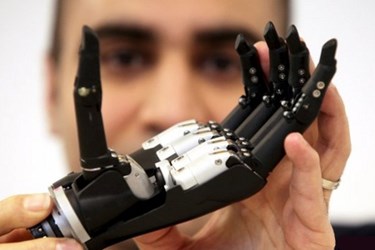Scientists Developing Bionic Hand That Provides Realistic Tactile Sensations

UK scientists have launched a $2.2 million dollar project to design a “bionic hand” capable of communicating tactile sensations to the brain. If the effort is successful, the virtual hand will sense temperature, pressure, and position, allowing the patient more versatile and realistic sensations.
The design plan uses electrodes to connect the device to the nerve ending network in the arm and will use fingertip sensors to collect and communicate information. Not only would patients be able to “feel” things, they would also be able to sense the position and movement of the device itself.
Scientists from Newcastle University will gather input from the Universities of Leeds, Essex, Keele, and Southhampton, as well as the Imperial College Londo, in order to implement the design plan, according to a Newcastle University press release.
Much prosthetic innovation and research is devoted to improving communication between the prosthetic and the brain. Existing models rely on muscle flexing and movement in the arm to operate the hand and require time for the patient to adapt to a new style of movement.
Rory O’Connor, senior lecturer in rehabilitation at the University of Leeds and clinical advisor to the project, explains, “The current designs are like a plug and socket. The socket fits over the end of the limb and picks up signals from the muscles. The prosthesis fits onto this and by learning to flex certain muscles the patient can work the hand.”
According to O’Connor, a major drawback and limitation of this approach is that many patients requiring prosthetic hands have sustained considerable muscle damage as a result of the accident that claimed their limb. As such, a prosthetic device requiring muscle control is not feasible for all patients.
By designing a system that connects directly to nerve endings, on the other hand, scientists hope to provide a more realistic experience to a wider variety of patients.
“If we can design a system that allows this two way communication it would help people to naturally reach out and pick up a glass, for example, whilst maintaining eye contact in a conversation, or pick up an apple without bruising it,” said Kianoush Nazarpour, the project leader and biomedical engineering lecturer at Newcastle University, in the press release.
The Engineering and Physical Sciences Research Council (EPSRC), UK’s primary agency for funding research in engineering and the physical sciences, provided $2.2 million in support for the project.
“What patients tell us is they want something that is more intuitive and more closely replicates the natural movement and feel of a real hand and that is what we hope to achieve through this project,” O’Connor concluded.
Image credit: Newcastle University
